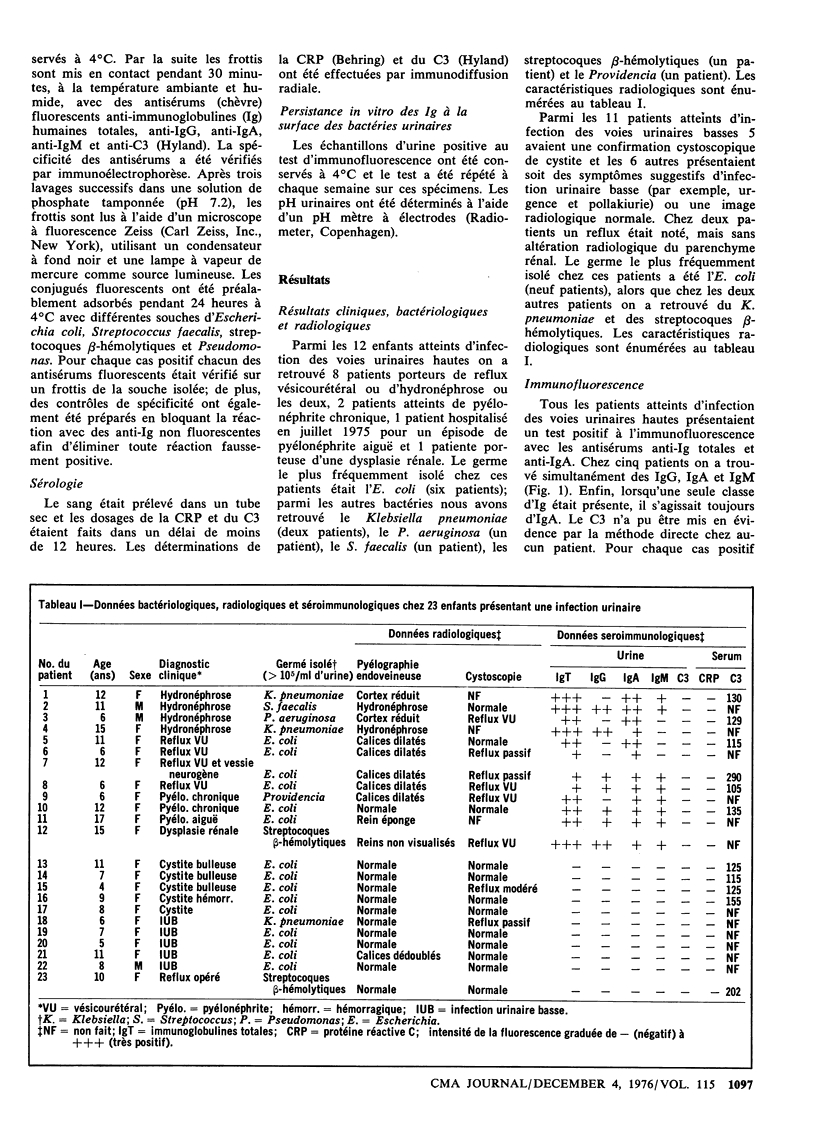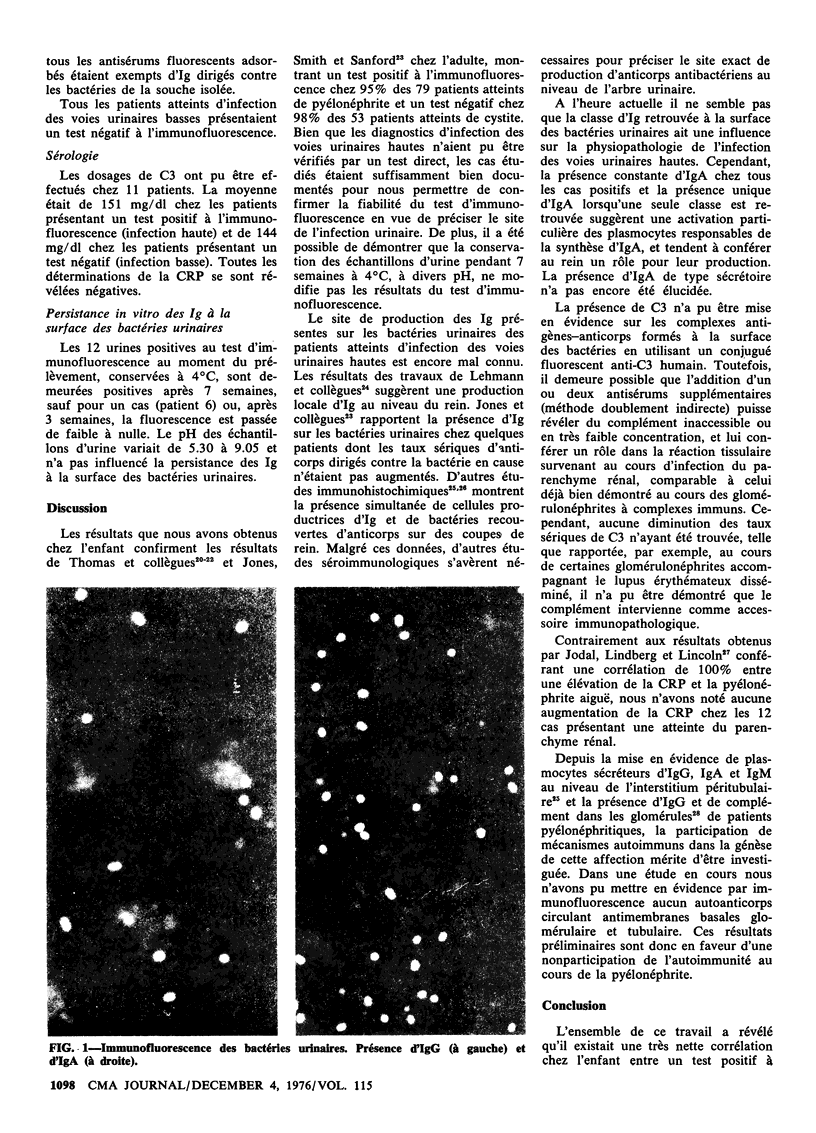Abstract
The demonstration by immuno-fluorescence of antibodies on the surface of urinary bacteria, a new method of determining the site of a urinary tract infection, was found to be as valuable in children as it is in adults. A clear correlation exists between a positive test result and renal parenchymal infection on one hand, and a negative result and lower urinary tract infection on the other. Moreover, immunoglobulins were still detectable in original positive urine samples that had been standing at 4degrees C for 7 weeks. The constant finding of IgA on bacteria suggests a particular synthesis for this class of immunoglobulin. A pathophysiologic role for complement would appear to be excluded by the facts that the serum concentrations of C3 were normal and that C3 was invariably absent from the bacterial surface.
Full text
PDF



Images in this article
Selected References
These references are in PubMed. This may not be the complete list of references from this article.
- Beregi E., Hamvas A., Rényi-Vámos F. Immunhistological studies in chronic pyelonephritis. Clin Nephrol. 1974;2(3):113–115. [PubMed] [Google Scholar]
- Cohen M. Urinary tract infections in children. I. Females aged 2 through 14, first two infections. Pediatrics. 1972 Aug;50(2):271–278. [PubMed] [Google Scholar]
- Cotran R. S. Immunopathology of pyelonephritis: studies on the pathogenesis and diagnosis of the renal lesion. Verh Dtsch Ges Inn Med. 1974;80:841–848. doi: 10.1007/978-3-642-85449-1_243. [DOI] [PubMed] [Google Scholar]
- Dodge W. F., West E. F., Fras P. A., Travis L. B. Detection of bacteriuria in children. J Pediatr. 1969 Jan;74(1):107–110. doi: 10.1016/s0022-3476(69)80015-6. [DOI] [PubMed] [Google Scholar]
- Fairley K. F., Bond A. G., Brown R. B., Habersberger P. Simple test to determine the site of urinary-tract infection. Lancet. 1967 Aug 26;2(7513):427–428. doi: 10.1016/s0140-6736(67)90849-5. [DOI] [PubMed] [Google Scholar]
- Jodal U., Lindberg U., Lincoln K. Level diagnosis of symptomatic urinary tract infections in childhood. Acta Paediatr Scand. 1975 Mar;64(2):201–208. doi: 10.1111/j.1651-2227.1975.tb03822.x. [DOI] [PubMed] [Google Scholar]
- Jones S. R., Smith J. W., Sanford J. P. Localization of urinary-tract infections by detection of antibody-coated bacteria in urine sediment. N Engl J Med. 1974 Mar 14;290(11):591–593. doi: 10.1056/NEJM197403142901103. [DOI] [PubMed] [Google Scholar]
- KUNIN C. M., ZACHA E., PAQUIN A. J., Jr Urinary-tract infections in schoolchildren. I. Prevalence of bacteriuria and associated urologic findings. N Engl J Med. 1962 Jun 21;266:1287–1296. doi: 10.1056/NEJM196206212662501. [DOI] [PubMed] [Google Scholar]
- Kunin C. M. Emergence of bacteriuria, proteinuria, and symptomatic urinary tract infections among a population of school girls followed for 7 years. Pediatrics. 1968 May;41(5):968–976. [PubMed] [Google Scholar]
- Lehmann J. D., Smith J. W., Miller T. E., Barnett J. A., Sanford J. P. Local immune response in experimental pyelonephritis. J Clin Invest. 1969 Nov;47(11):2541–2550. doi: 10.1172/JCI105936. [DOI] [PMC free article] [PubMed] [Google Scholar]
- Ronald A. R., Cutler R. E., Turck M. Effect of bacteriuria on renal concentrating mechanisms. Ann Intern Med. 1969 Apr;70(4):723–733. doi: 10.7326/0003-4819-70-4-723. [DOI] [PubMed] [Google Scholar]
- Thomas V. L., Forland M., Shelokov A. Immunoglobulin levels and antibody-coated bacteria in urines from patients with urinary tract infections. Proc Soc Exp Biol Med. 1975 Apr;148(4):1198–1201. doi: 10.3181/00379727-148-38716. [DOI] [PubMed] [Google Scholar]
- Thomas V., Shelokov A., Forland M. Antibody-coated bacteria in the urine and the site of urinary-tract infection. N Engl J Med. 1974 Mar 14;290(11):588–590. doi: 10.1056/NEJM197403142901102. [DOI] [PubMed] [Google Scholar]
- Uttley W. S., Paxton J., Thistlethwaite D. Urinary concentrating ability and growth failure in urinary tract disorders. Arch Dis Child. 1972 Jun;47(253):436–441. doi: 10.1136/adc.47.253.436. [DOI] [PMC free article] [PubMed] [Google Scholar]



